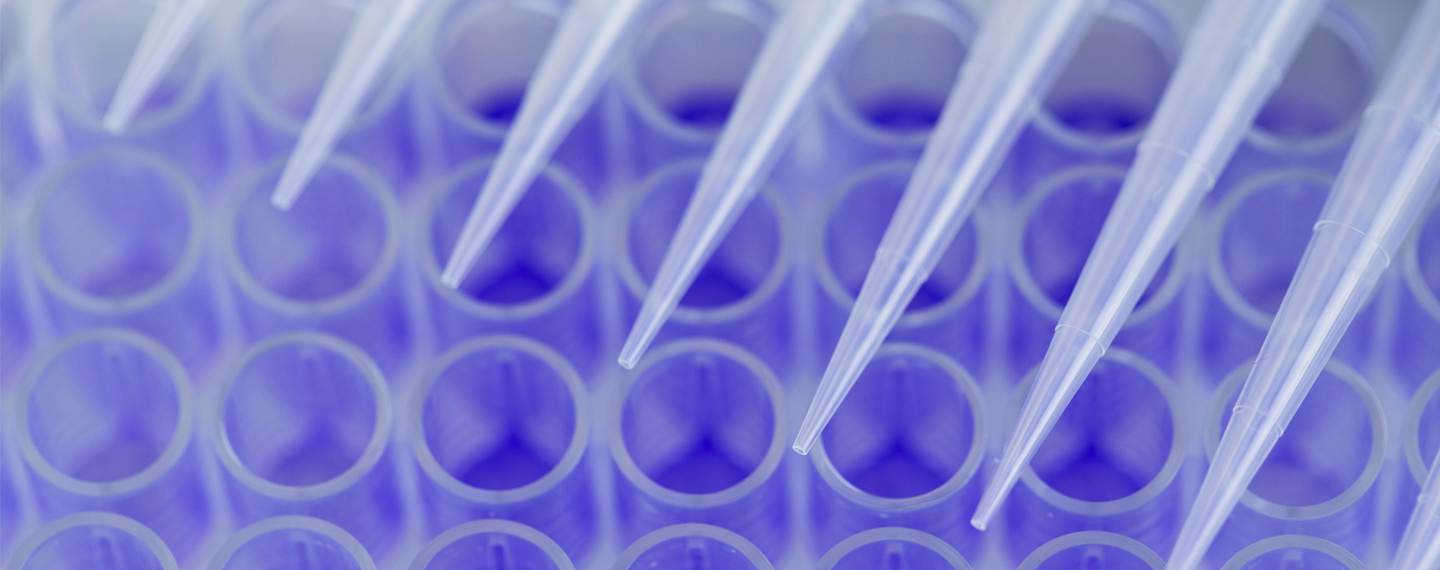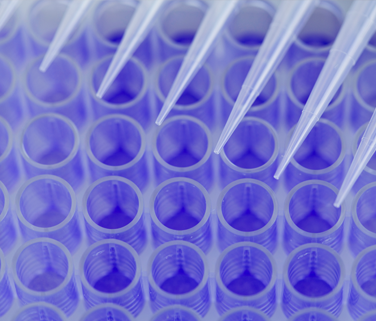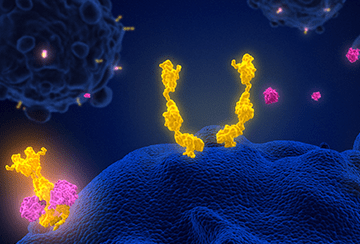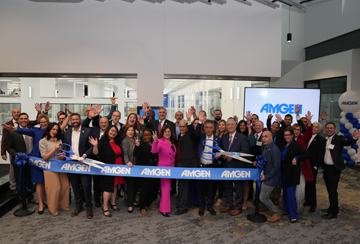In 2020, Amgen’s biosimilars portfolio reached several milestones – including its fifth biosimilar approval from the U.S. Food and Drug Administration (FDA) and two market launches – making additional treatment options available for patients living with inflammatory diseases and certain cancers. The company’s commitment to develop high-quality biosimilars to contribute to cost savings and greater flexibility of choice for patients and healthcare providers was made a decade ago and has heighted relevance in the wake of COVID-19.
As we look to the year ahead, here are five things to watch about Amgen Biosimilars and the U.S. marketplace with biosimilars:
1. Amgen’s fourth U.S. biosimilar launch
Amgen recently launched its fourth biosimilar product in the U.S., RIABNI™ (rituximab-arrx), a biosimilar to Rituxan® (rituximab), creating an additional treatment option for oncology patients. As the third product launch in Amgen’s oncology biosimilar portfolio, this milestone reflects the company’s commitment to providing high-quality biosimilars and delivering cost savings for patients, physicians, payers, hospitals and health systems over the long term.
2. Savings generated across multiple therapeutic areas
To date, the FDA has approved 29 biosimilar products, with more approvals and launches anticipated in 2021 across oncology, oncology supportive care, nephrology/oncology supportive care, and inflammation.1 These approvals may provide patients, physicians and payers a range of lower-cost treatment options and a degree of flexibility of choice in therapies that they may not otherwise have.2 Biosimilars have gained significant share in the majority of therapeutic areas where they have been introduced, and an IQVIA analysis estimates that savings enabled by the presence of biosimilars in the U.S. are modeled to exceed $100 billion in aggregate over the next five years.3
3. Increased competition in the marketplace with biosimilars
Amid COVID-19-driven budget pressure, competition among biologics, particularly through the introduction of biosimilars, has the potential to provide cost savings for governments, hospitals and patients, while maintaining treatment standards. Amgen has seen firsthand that as market-based competition grows, biosimilar usage increases and the reference product’s average sales price (ASP) decreases. For example, take the recent launches of our two oncology biosimilars in the U.S., which captured 34% and 44% of their respective shares after roughly one year in the marketplace.4
4. Continued growth in the U.S. marketplace
The seventh edition of Amgen’s annual Biosimilar Trends Report revealed important signs of overall growth for the U.S. marketplace with biosimilars, with a 65% increase in biosimilar approvals by the FDA and a 157% increase in their availability in just one year. The U.S. marketplace is poised to welcome many new biosimilars in 2021 and beyond, spurring additional competition that will potentially lead to significant savings for the healthcare system. In turn, these savings can be deployed to newer, innovative treatments.
5. Increased stakeholder awareness and education
The Amgen biosimilars journey started 10 years ago with a commitment to invest $2 billion across a portfolio of 10 biosimilar medicines, potentially offering more affordable, effective treatment options for serious diseases and contributing to the sustainability of healthcare systems. To learn more, please visit AmgenBiosimilars.com, as well as the BioEngage: Inside Biosimilars microsite, which provides up-to-date educational materials about biosimilars, including: what they are; how they are manufactured, developed, approved, and prescribed; as well as the impact biosimilars are expected to have on the healthcare system.
- U.S. Food and Drug Administration. FDA-Approved Biosimilar Products. URL: https://www.fda.gov/drugs/biosimilars/biosimilar-product-information. Accessed December 2020.
- U.S. Food and Drug Administration. Biosimilar and Interchangeable Biologics: More Treatment Choices. March 23, 2020. URL: https://www.fda.gov/consumers/consumer-updates/biosimilar-and-interchangeable-biologics-more-treatment-choices#:~:text=Biosimilar%20and%20Interchangeable%20Biologics%3A%20More%20Treatment%20Choices,-Subscribe%20to%20Email&text=The%20U.S.%20Food%20and%20Drug,arthritis%2C%20psoriasis%2C%20and%20more. Accessed December 2020.
- IQVIA Institute. An IQVIA analysis estimates that savings enabled by the presence of biosimilars are modeled to exceed $100 billion in aggregate over the next five years in the U.S. September 29, 2020. URL: https://www.iqvia.com/insights/the-iqvia-institute/reports/biosimilars-in-the-united-states-2020-2024. Accessed December 2020.
- Amgen. Amgen Reports Third Quarter 2020 Financial Results. October 28, 2020. URL: https://www.amgen.com/media/news-releases/2020/10/amgen-reports-third-quarter-2020-financial-results/. Accessed December 2020.
About RIABNI™ (rituximab-arrx) in the U.S.
RIABNI is a biosimilar to Rituxan, an anti-CD20 monoclonal antibody. The active ingredient of RIABNI is a monoclonal antibody that has the same amino acid sequence as Rituxan. RIABNI also has the same strength as Rituxan, and the dosage form and route of administration are identical to the IV formulation of Rituxan.
In the U.S., RIABNI is approved for:
Non-Hodgkin’s Lymphoma (NHL)
RIABNI (rituximab-arrx) is indicated for the treatment of adult patients with:
- Relapsed or refractory, low-grade or follicular, CD20-positive, B-cell NHL as a single agent.
- Previously untreated follicular, CD20-positive, B-cell NHL in combination with first line chemotherapy and, in patients achieving a complete or partial response to a rituximab product in combination with chemotherapy, as single-agent maintenance therapy.
- Non-progressing (including stable disease), low-grade, CD20-positive, B-cell NHL as a single agent after first line cyclophosphamide, vincristine, and prednisone (CVP) chemotherapy.
- Previously untreated diffuse large B-cell, CD20-positive NHL in combination with cyclophosphamide, doxorubicin, vincristine, prednisone (CHOP) or other anthracycline-based chemotherapy regimens.
Chronic Lymphocytic Leukemia (CLL)
RIABNI, in combination with fludarabine and cyclophosphamide (FC), is indicated for the treatment of adult patients with previously untreated and previously treated CD20-positive CLL.
Granulomatosis with Polyangiitis (GPA) (Wegener’s Granulomatosis) and Microscopic Polyangiitis (MPA)
RIABNI, in combination with glucocorticoids, is indicated for the treatment of adult patients with Granulomatosis with Polyangiitis (GPA) (Wegener’s Granulomatosis) and Microscopic Polyangiitis (MPA).
Important Safety Information
BOXED WARNINGS: FATAL INFUSION-RELATED REACTIONS, SEVERE MUCOCUTANEOUS REACTIONS, HEPATITIS B VIRUS REACTIVATION, PROGRESSIVE MULTIFOCAL LEUKOENCEPHALOPATHY
- Infusion-Related Reactions: Rituximab product administration can result in serious, including fatal, infusion-related reactions. Deaths within 24 hours of rituximab infusion have occurred. Approximately 80% of fatal infusion-related reactions occurred in association with the first infusion. Monitor patients closely. Discontinue RIABNI™ infusion for severe reactions and provide medical treatment for Grade 3 or 4 infusion-related reactions.
- Severe Mucocutaneous Reactions: Severe, including fatal, mucocutaneous reactions can occur in patients receiving rituximab products. Discontinue RIABNI™ in patients who experience a severe mucocutaneous reaction. The safety of readministration of RIABNI™ to patients with severe mucocutaneous reactions has not been determined.
- Hepatitis B Virus (HBV) Reactivation: HBV reactivation can occur in patients treated with rituximab products, in some cases resulting in fulminant hepatitis, hepatic failure, and death. Screen all patients for HBV infection before treatment initiation, and monitor patients during and after treatment with RIABNI™. Discontinue RIABNI™ and concomitant medications in the event of HBV reactivation.
- Progressive Multifocal Leukoencephalopathy (PML), including fatal PML, can occur in patients receiving rituximab products. Discontinue RIABNI™ and consider discontinuation or reduction of any concomitant chemotherapy or immunosuppressive therapy in patients who develop PML.
Infusion-Related reactions (IRR)
- Rituximab products can cause severe, including fatal, infusion-related reactions. Severe reactions typically occurred during the first infusion with time to onset of 30-120 minutes.
- Rituximab-product-induced infusion-related reactions and sequelae include urticaria, hypotension, angioedema, hypoxia, bronchospasm, pulmonary infiltrates, acute respiratory distress syndrome, myocardial infarction, ventricular fibrillation, cardiogenic shock, anaphylactoid events, or death.
- Premedicate patients with an antihistamine and acetaminophen prior to dosing. For patients with Granulomatosis with Polyangiitis (GPA) (Wegener’s Granulomatosis) and Microscopic Polyangiitis (MPA), methylprednisolone 100 mg intravenously or its equivalent is recommended 30 minutes prior to each infusion. Institute medical management (e.g., glucocorticoids, epinephrine, bronchodilators, or oxygen) for infusion-related reactions as needed. Depending on the severity of the infusion-related reaction and the required interventions, temporarily or permanently discontinue RIABNI™. Resume infusion at a minimum 50% reduction in rate after symptoms have resolved.
- Closely monitor the following patients: those with preexisting cardiac or pulmonary conditions, those who experienced prior cardiopulmonary adverse reactions, and those with high numbers of circulating malignant cells (≥25,000/mm3).
Severe Mucocutaneous Reactions
- Mucocutaneous reactions, some with fatal outcome, can occur in patients treated with rituximab products. These reactions include paraneoplastic pemphigus, Stevens-Johnson syndrome, lichenoid dermatitis, vesiculobullous dermatitis, and toxic epidermal necrolysis.
- The onset of these reactions has been variable and includes reports with onset on the first day of rituximab exposure. Discontinue RIABNI™ in patients who experience a severe mucocutaneous reaction. The safety of re-administration of rituximab products to patients with severe mucocutaneous reactions has not been determined.
Hepatitis B Virus Reactivation
- Hepatitis B virus (HBV) reactivation, in some cases resulting in fulminant hepatitis, hepatic failure, and death, can occur in patients treated with drugs classified as CD20-directed cytolytic antibodies, including rituximab products. Cases have been reported in patients who are hepatitis B surface antigen (HBsAg) positive and also in patients who are HBsAg negative but are hepatitis B core antibody (anti-HBc) positive. Reactivation also has occurred in patients who appear to have resolved hepatitis B infection (i.e., HBsAg negative, anti-HBc positive, and hepatitis B surface antibody [anti-HBs] positive).
- HBV reactivation is defined as an abrupt increase in HBV replication manifesting as a rapid increase in serum HBV DNA level or detection of HBsAg in a person who was previously HBsAg negative and anti-HBc positive. Reactivation of HBV replication is often followed by hepatitis, i.e., increase in transaminase levels. In severe cases, increase in bilirubin levels, liver failure, and death can occur.
- Screen all patients for HBV infection by measuring HBsAg and anti-HBc before initiating treatment with RIABNI™. For patients who show evidence of prior hepatitis B infection (HBsAg positive [regardless of antibody status] or HBsAg negative but anti-HBc positive), consult with physicians with expertise in managing hepatitis B regarding monitoring and consideration for HBV antiviral therapy before and/or during RIABNI™ treatment.
- Monitor patients with evidence of current or prior HBV infection for clinical and laboratory signs of hepatitis or HBV reactivation during and for several months following RIABNI™ therapy. HBV reactivation has been reported up to 24 months following completion of rituximab therapy.
- In patients who develop reactivation of HBV while on RIABNI™, immediately discontinue RIABNI™ and any concomitant chemotherapy, and institute appropriate treatment. Insufficient data exist regarding the safety of resuming rituximab product treatment in patients who develop HBV reactivation. Resumption of RIABNI™ treatment in patients whose HBV reactivation resolves should be discussed with physicians with expertise in managing HBV.
Progressive Multifocal Leukoencephalopathy (PML)
- JC virus infection resulting in multifocal leukoencephalopathy (PML) and death can occur in rituximab-product -treated patients with hematologic malignancies or with autoimmune diseases. The majority of patients with hematologic malignancies diagnosed with PML received rituximab in combination with chemotherapy or as part of a hematopoietic stem cell transplant. The patients with autoimmune diseases had prior or concurrent immunosuppressive therapy. Most cases of PML were diagnosed within 12 months of their last infusion of rituximab.
- Consider the diagnosis of PML in any patient presenting with new-onset neurologic manifestations. Evaluation of PML includes, but is not limited to, consultation with a neurologist, brain MRI, and lumbar puncture. Discontinue RIABNI™ and consider discontinuation or reduction of any concomitant chemotherapy or immunosuppressive therapy in patients who develop PML.
Tumor Lysis Syndrome
- Acute renal failure, hyperkalemia, hypocalcemia, hyperuricemia, or hyperphosphatemia from tumor lysis, some fatal, can occur within 12−24 hours after the first infusion of RIABNI™ in patients with non-Hodgkin’s lymphoma (NHL). A high number of circulating malignant cells (≥25,000/mm3), or high tumor burden, confers a greater risk of TLS.
- Administer aggressive intravenous hydration and anti-hyperuricemic therapy in patients at high risk for TLS. Correct electrolyte abnormalities, monitor renal function and fluid balance, and administer supportive care, including dialysis as indicated.
Infections
- Serious, including fatal, bacterial, fungal, and new or reactivated viral infections can occur during and following the completion of rituximab product-based therapy. Infections have been reported in some patients with prolonged hypogammaglobulinemia (defined as hypogammaglobulinemia >11 months after rituximab exposure).
- New or reactivated viral infections included cytomegalovirus, herpes simplex virus, parvovirus B19, varicella zoster virus, West Nile virus, and hepatitis B and C. Discontinue RIABNI™ for serious infections and institute appropriate anti-infective therapy.
- RIABNI™ is not recommended for use in patients with severe, active infections.
Cardiovascular Adverse Reactions
- Cardiac adverse reactions, including ventricular fibrillation, myocardial infarction, and cardiogenic shock may occur in patients receiving rituximab products. Discontinue infusions for serious or life-threatening cardiac arrhythmias. Perform cardiac monitoring during and after all infusions of RIABNI™ for patients who develop clinically significant arrhythmias, or who have a history of arrhythmia or angina.
Renal Toxicity
- Severe, including fatal, renal toxicity can occur after rituximab product administration in patients with NHL. Renal toxicity has occurred in patients who experience TLS and in patients with NHL administered concomitant cisplatin therapy during clinical trials. The combination of cisplatin and RIABNI™ is not an approved treatment regimen. Monitor closely for signs of renal failure and discontinue RIABNI™ in patients with a rising serum creatinine or oliguria.
Bowel Obstruction and Perforation
- Abdominal pain, bowel obstruction and perforation, in some cases leading to death, can occur in patients receiving rituximab products in combination with chemotherapy. In postmarketing reports, the mean time to documented gastrointestinal perforation was 6 (range 1−77) days in patients with NHL. Evaluate if symptoms of obstruction such as abdominal pain or repeated vomiting occur.
Immunization
- The safety of immunization with live viral vaccines following rituximab product therapy has not been studied, and vaccination with live virus vaccines is not recommended before or during treatment.
- For patients treated with RIABNI™, physicians should review the patient’s vaccination status and patients should, if possible, be brought up to date with all immunizations in agreement with current immunization guidelines prior to initiating RIABNI™; administer non-live vaccines at least 4 weeks prior to a course of RIABNI™.
Embryo-Fetal Toxicity
- Based on human data, rituximab products can cause fetal harm due to B-cell lymphocytopenia in infants exposed in utero. Advise pregnant women of the potential risk to a fetus. Advise females of reproductive potential to use effective contraception with RIABNI™ and for at least 12 months after the last dose.
Concomitant Use with Other Biologic Agents and Disease Modifying Antirheumatic Drugs (DMARDs) in GPA and MPA
- Limited data are available on the safety of the use of biologic agents or DMARDs. Observe patients closely for signs of infection if biologic agents and/or DMARDs are used concomitantly. Use of concomitant immunosuppressants other than corticosteroids has not been studied in GPA or MPA patients exhibiting peripheral B-cell depletion following treatment with rituximab products.
Adverse Reactions
- The most common Grade 3 or 4 adverse reactions in clinical trials of NHL and chronic lymphocytic leukemia (CLL) were infusion-related reactions, neutropenia, leukopenia, anemia, thrombocytopenia, and infections. Additionally, lymphopenia and lung disorder were seen in NHL trials; and febrile neutropenia, pancytopenia, hypotension, and hepatitis B were seen in CLL trials.
- The most common adverse reactions (incidence ≥25%) in clinical trials of NHL and CLL were infusion-related reactions. Additionally, fever, lymphopenia, chills, infection, and asthenia were seen in NHL trials; and neutropenia was seen in CLL trials.
Nursing Mothers
- There are no data on the presence of rituximab products in human milk, the effect on the breastfed child, or the effect on milk production. Because of the potential of serious adverse reactions in the breastfed child, advise women not to breastfeed during treatment with RIABNI™ and for at least 6 months after the last dose.
Clinical Trials Experience in GPA and MPA
- Adverse reactions reported in ≥15% of rituximab-treated patients were infections, nausea, diarrhea, headache, muscle spasms, anemia, and peripheral edema (other important adverse reactions include infusion-related reactions).
Induction Treatment of Patients with Active GPA/MPA (GPA/MPA Study 1) Infusion-Related Reactions
- In GPA/MPA Study 1, 12% vs 11% (rituximab-treated vs cyclophosphamide-treated, respectively) of patients experienced at least one infusion-related reaction. Infusion-related reactions included cytokine release syndrome, flushing, throat irritation, and tremor. In the rituximab group, the proportion of patients experiencing an infusion reaction was 12%, 5%, 4%, and 1% following the first, second, third, and fourth infusions, respectively. Patients were premedicated with antihistamine and acetaminophen before each rituximab infusion and were on background oral corticosteroids, which may have mitigated or masked an infusion-related reaction; however, there is insufficient evidence to determine whether premedication diminishes the frequency or severity of infusion-related reactions.
Infections
- In GPA/MPA Study 1, 62% vs 47% (rituximab-treated vs cyclophosphamide-treated, respectively) of patients experienced an infection by Month 6. The most common infections in the rituximab group were upper respiratory tract infections, urinary tract infections, and herpes zoster. The incidence of serious infections was 11% vs 10% (rituximab-treated vs cyclophosphamide-treated, respectively), with rates of approximately 25 and 28 per 100 patient-years, respectively. The most common serious infection was pneumonia.
Hypogammaglobulinemia
- Hypogammaglobulinemia (IgA, IgG, or IgM below the lower limit of normal) has been observed in patients with GPA and MPA treated with rituximab in GPA/MPA Study 1. At 6 months, in the rituximab group, 27%, 58%, and 51% of patients with normal immunoglobulin levels at baseline had low IgA, IgG, and IgM levels, respectively, compared to 25%, 50%, and 46% in the cyclophosphamide group.
Immunogenicity
- A total of 23/99 (23%) rituximab-treated adult patients with GPA or MPA tested positive for anti-rituximab antibodies by 18 months in GPA/MPA Study 1. The clinical relevance of anti-rituximab antibody formation in rituximab-treated adult patients is unclear.
Treatment of Patients with GPA/MPA Who Have Achieved Disease Control with Induction Treatment (GPA/MPA Study 2)
- In GPA/MPA Study 2, the safety profile was consistent with the known safety profile of rituximab in immunologic indications.
Infusion-Related Reactions (IRR)
- In GPA/MPA Study 2, 7/57 (12%) patients in the non-US-licensed approved rituximab arm reported infusion-related reactions. The incidence of IRR symptoms was highest during or after the first infusion (9%) and decreased with subsequent infusions (<4%). One patient had two serious IRRs; two IRRs led to a dose modification; and no IRRs were severe, fatal, or led to withdrawal from the study.
Infections
- In GPA/MPA Study 2, 30/57 (53%) patients in the non-US-licensed approved rituximab arm and 33/58 (57%) in the azathioprine arm reported infections. The incidence of all-grade infections was similar between the arms. The incidence of serious infections was similar in both arms (12%). The most commonly reported serious infection in the group was mild or moderate bronchitis.
Please see the full Prescribing Information, including BOXED WARNINGS and Medication Guide, for additional Important Safety Information.





